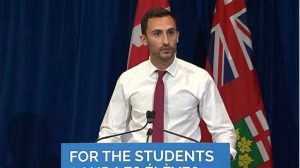Stephen Lecce using students as chips to bargain with teachers
It’s a typical move for school kids stuck in a bit of a conflict to insist they were doing the right thing and blame the other guy for the problem. That seems to be the tactic of choice for Education Minister Stephen Lecce, well-schooled in the methods of spin during his time working for the Stephen Harper government.
 He was certainly smooth in a press conference at the end of October when he was explaining how much the Tories had listened to parents over the past while – despite taking a chainsaw to education, social services, housing, cities, health care – with all the legislation this “for the people” government slammed through as it sought to cut 4 per cent across the board in its budget.
He was certainly smooth in a press conference at the end of October when he was explaining how much the Tories had listened to parents over the past while – despite taking a chainsaw to education, social services, housing, cities, health care – with all the legislation this “for the people” government slammed through as it sought to cut 4 per cent across the board in its budget.
Mr. Lecce spoke of hiring psychologists to improve kids’ mental health, when actually a huge board like the TDSB has had to cut psychologists and social workers because his Ministry of Education has cut its budget. He claims that his government has provided more education workers for the classroom at a time when these folks too have been cut from classrooms. The Ministry he said has revised the math curriculum; actually it hasn’t- the one from 2005 is still there. Schools are falling apart? Mr. Lecce has $500 million to fix them; this is roughly what the Liberals shelled out each of the past few years and is a pittance compared to the $1.6 billion per year needed to deal with the $16.3 billion backlog currently mounting.
Then he came to the real point of the press conference by announcing that instead of increasing high school class sizes to 28 he would stop short by increasing them only to 25 over the next four years. This change of heart came not because it was an awful idea in the first place but because “the government can and should go further to incent a deal that keeps kids in class.”
So, this offer wasn’t about listening to parents or pedagogy or common sense; it was about getting a deal with the Ontario Secondary School Teachers Federation (OSSTF) or at least trying to undercut their bargaining position, so if secondary teachers support strike action on November 15 – whatever follows is all on them.
Had Mr. Lecce been listening to the thousands of parents across the province yelling loudly as they attended walk-ins at their local schools last month, he wouldn’t be offering to cap class sizes at 25 – and bear in mind that this is an average size for school board; classes go much higher than that. He’d say: “We got it completely wrong. We’re going back to an average of 22 kids per teacher in high school classes across Ontario. We’re going to fund education properly with a formula based on need rather than averages.”
Just to make it clear this wasn’t about doing the right thing, Mr. Lecce went on to complain that OSSTF had ignored conciliation and asked to be in a legal strike position. “We have been bargaining every day in good faith since the beginning of this process,” he said, adding that the union wasn’t willing to listen despite this “reasonable and thoughtful” proposal.
But it’s more like proposing to cut off half your leg when the original threat was to take the whole thing. It still means cutting 5 000 secondary teaching jobs from the province along with the loss of courses and opportunities for smaller classes that entails. It doesn’t change anything about what the government has already cut from local budgets. Stephen Lecce is giving a little bit to try and put teachers on the defensive when they quite rightly say: “That’s not enough. Schools have endured enough cuts over the years. You can’t go any further.”

There’s another twist to this story: local school boards being able to hike class sizes. The Minister neglected to answer whether or not local caps to class sizes were scrapped in this latest proposal. This means that local school boards could be able to increase class sizes as much as they see fit. This is especially relevant when so many boards are looking for ways to deal with budget cuts. OSSTF president Harvey Bischof said that “the proposal it received from the Ministry was worse than the government’s original plan to hike class size ratios to 28:1…” adding that with the removal of locally-enforceable class size caps, there would essentially be no limits on the size of classes into which Ontario students could be squeezed.” Has Mr. Lecce left it to the school boards to get those class sizes up?
School Magazine’s questions about this to Minister Lecce’s office remain unanswered.
Is this bargaining in good faith? No – particularly when you consider that last week, the Tories passed legislation limiting wage increases to 1 percent for teachers and other public sector workers in colleges, universities, hospitals and others including agencies that receive over $1 million in funding from the government. That’s below the annual inflation rate, pegged at between 1.5 and 2.4 percent. What recourse do teachers and other public sector workers have?
It’s a real insight into this minister’s true intentions when, about halfway through the press conference, he points out: “For a person observing, perhaps for a family observing… I think it is an important contrast that one party at the table the crown the government – this government every single day is representing a reasonableness that is not necessarily being matched by the union.”
It’s not about keeping kids in school – something he piously repeats throughout the conference. He’s using them as bargaining chips – warning unions what parents might say, if teachers decide to take strike action.
Teachers should ignore this not-so-veiled threat and move ahead with whatever job action it takes to restore classes to a size that makes them reasonable to teach. This, not Stephen Lecce’s half measure, respects Ontario students.

